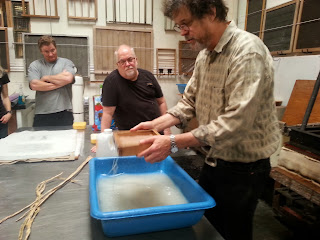As I've been working on these recent collages, it's come to me that as an artist, my studio practice has frequently swung between highly detailed, dense works, and very minimal, materially sensitive, distilled pieces. With these collages, with their layers of printed imagery and cut paper, things feel like I'm currently in a dense stage.
Click on images for larger view.
It's interesting, because after spending months and months making pieces like this one, or this, or this, which are basically just paper, these collages come together in a matter of hours at most. (Although, if I counted all the time that led to the waste prints and paper that went into assembling the collage, it would be much, much longer). Of course, the paper portfolios are also editions, while the collages are unique works.
I think most artists who have made minimal work that is similar to my linked examples will agree that the precision required to work on something that is so exacting and simple is often as equally challenging to produce as something complex and highly detailed. There's just no wiggle room.
However, I find myself wondering what these divergent methods mean to my overall practice. I keep coming back to the concept of distilling when I think of the paper portfolios - I had clarified my vision and ideas down to a material essence and process. Simultaneously, it's a challenge to myself - how good are my skills? (how much can I show off?) Completing such work honors the medium and its potential.
These collages are more ambiguous - multiple nonlinear narratives colliding, a burgeoning lexicon of imagery.
Right now, after all those months of meticulousness, getting to use all that lovely paper that Jerarde gave me last year, to layer, to delight in my love of pattern, it's a release to embrace complexity. It feels like an indulgence.

















































